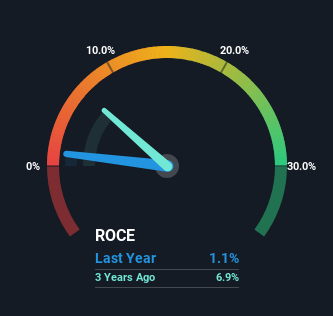- Sweden
- /
- Consumer Durables
- /
- OM:GHUS B
Götenehus Group (STO:GHUS B) Is Reinvesting At Lower Rates Of Return

Finding a business that has the potential to grow substantially is not easy, but it is possible if we look at a few key financial metrics. Firstly, we'd want to identify a growing return on capital employed (ROCE) and then alongside that, an ever-increasing base of capital employed. Put simply, these types of businesses are compounding machines, meaning they are continually reinvesting their earnings at ever-higher rates of return. Having said that, from a first glance at Götenehus Group (STO:GHUS B) we aren't jumping out of our chairs at how returns are trending, but let's have a deeper look.
What Is Return On Capital Employed (ROCE)?
If you haven't worked with ROCE before, it measures the 'return' (pre-tax profit) a company generates from capital employed in its business. The formula for this calculation on Götenehus Group is:
Return on Capital Employed = Earnings Before Interest and Tax (EBIT) ÷ (Total Assets - Current Liabilities)
0.011 = kr13m ÷ (kr1.8b - kr653m) (Based on the trailing twelve months to March 2023).
Thus, Götenehus Group has an ROCE of 1.1%. In absolute terms, that's a low return and it also under-performs the Consumer Durables industry average of 7.9%.
View our latest analysis for Götenehus Group

Historical performance is a great place to start when researching a stock so above you can see the gauge for Götenehus Group's ROCE against it's prior returns. If you want to delve into the historical earnings, revenue and cash flow of Götenehus Group, check out these free graphs here.
How Are Returns Trending?
In terms of Götenehus Group's historical ROCE movements, the trend isn't fantastic. To be more specific, ROCE has fallen from 20% over the last five years. Given the business is employing more capital while revenue has slipped, this is a bit concerning. If this were to continue, you might be looking at a company that is trying to reinvest for growth but is actually losing market share since sales haven't increased.
What We Can Learn From Götenehus Group's ROCE
In summary, we're somewhat concerned by Götenehus Group's diminishing returns on increasing amounts of capital. Long term shareholders who've owned the stock over the last five years have experienced a 30% depreciation in their investment, so it appears the market might not like these trends either. Unless there is a shift to a more positive trajectory in these metrics, we would look elsewhere.
If you want to know some of the risks facing Götenehus Group we've found 4 warning signs (2 don't sit too well with us!) that you should be aware of before investing here.
For those who like to invest in solid companies, check out this free list of companies with solid balance sheets and high returns on equity.
New: Manage All Your Stock Portfolios in One Place
We've created the ultimate portfolio companion for stock investors, and it's free.
• Connect an unlimited number of Portfolios and see your total in one currency
• Be alerted to new Warning Signs or Risks via email or mobile
• Track the Fair Value of your stocks
Have feedback on this article? Concerned about the content? Get in touch with us directly. Alternatively, email editorial-team (at) simplywallst.com.
This article by Simply Wall St is general in nature. We provide commentary based on historical data and analyst forecasts only using an unbiased methodology and our articles are not intended to be financial advice. It does not constitute a recommendation to buy or sell any stock, and does not take account of your objectives, or your financial situation. We aim to bring you long-term focused analysis driven by fundamental data. Note that our analysis may not factor in the latest price-sensitive company announcements or qualitative material. Simply Wall St has no position in any stocks mentioned.
About OM:GHUS B
Götenehus Group
Götenehus Group AB (publ) develops and constructs housing projects in Sweden.
Imperfect balance sheet with poor track record.
Market Insights
Community Narratives



